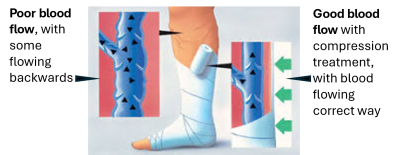New test
About compression treatment
Compression treatment helps the return of blood from your lower legs up towards your heart.
Treatment is with either:
- stockings or socks (together sometimes called ‘hosiery’)
- bandages
- wraps.
A doppler test will be done to check the blood flow in your legs and feet. This is done with using ultrasound on the skin. Then a specialist nurse will decide what treatment will work best for you.
Why it is needed
Compression treatment supports poor blood flow in the legs. This
- helps to prevent back flow or leaking of blood, such as when you have varicose veins
- helps healing, such as when you have a wound (known as an ‘ulcer) caused by poor circulation
- helps to reduce swelling caused by fluid leaking out of the veins.

Signs of poor blood flow include:
- swelling in the lower legs and feet
- brown stains on the lower legs. This is caused by blood products, such as iron, leaking into the tissue beneath your skin. This is permanent.
- itchy or painful patches of skin on the lower leg and around the ankle
- bulging veins in the lower leg that ache when you walk or stand for a long time.
Choosing the right stocking or wrap
The nurse will measure your leg at the ankle, the widest part of your calf and your foot length.
You will have your thigh measured if the stockings or wraps need to be above the knee.
There are different strengths of compression stockings, and wraps can be applied at individual pressures.
The amount of compression, or firmness, you need will depend on:
- the results of your doppler test
- your medical history
- your current condition
- what you find comfortable.
Putting the stocking or wrap on
Stockings and wraps should be worn every day to be effective.
Stockings
Steps to putting a stocking on:
- Remove your watch and any jewellery so that they do not snag on the stocking.
- Turn the stocking inside out.
- Pull the toe of the stocking back inside the leg, up to the heel.
- Pull the stocking onto the foot, adjusting the heel to fit.
- Pull the stocking over the heel and smooth it over the ankle.
- Ease the remaining stocking up your leg, smoothing out any wrinkles.
Do not pull hard on the stocking or tug it from the ankle. This may stretch or tear the fabric, making it too loose.
Compression stockings can be tricky to get on! Wearing rubber gloves helps you grip the fabric. Stocking applicators, such as an Actiglide or Medi Butler, can also help.
Wraps
If you need to have wraps, you will be given a leaflet specifically about them.
Looking after the stocking or wraps
It is best to hand-wash all compression stockings or wraps, or use a low temperature cycle on your washing machine.
Do not use fabric softener or a tumble drier. These will make them lose their shape, becoming less effective.
If stockings get torn or ripped, they must be replaced. To do this, request a new prescription. Then discard the old ones.
Get a new prescription from your GP or Practice Nurse ever 3 to 6 months. You should be measured each time to make sure you get the correct size. Discard old stockings, which may have lost their elasticity.
General Advice
- Raise your legs when you sit or rest.
- Remove stockings at night when your legs are up in bed.
- Report any new wounds or skin changes (such as redness or itching) to your GP or nurse.
- Take short, frequent walks to encourage the blood flow in your legs.
- Do not sit with your legs or ankles crossed since this may restrict blood flow.
- Stop regularly on long journeys to walk and stretch your legs. If flying, walk up and down often to reduce the risk of developing a clot.
- Apply a cream for sensitive skin regularly to prevent dry skin, which may crack and cause a wound to develop.
- When putting cream on your legs, use downward strokes. Wait until the skin is dry before putting the stockings on. This is because a build-up of cream on the stockings can damage the fabric.
If you have any further questions, speak to your community nurse or tissue viability nurse.
Related information
Contact information
Tissue Viability Service
Teddington Health and Social Care Centre
Queen’s Road
TW11 0LR
Telephone:
020 8714 4085 (Monday to Friday)
If you have any concerns out of hours:
- phone 111 for advice
- or attend Teddington Urgent Treatment Centre